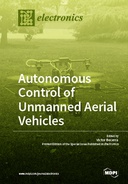Explore

Autonomous Control of Unmanned Aerial Vehicles
Victor Becerra
2019
0 Ungluers have
Faved this Work
Login to Fave
Unmanned aerial vehicles (UAVs) are being increasingly used in different applications in both military and civilian domains. These applications include surveillance, reconnaissance, remote sensing, target acquisition, border patrol, infrastructure monitoring, aerial imaging, industrial inspection, and emergency medical aid. Vehicles that can be considered autonomous must be able to make decisions and react to events without direct intervention by humans. Although some UAVs are able to perform increasingly complex autonomous manoeuvres, most UAVs are not fully autonomous; instead, they are mostly operated remotely by humans. To make UAVs fully autonomous, many technological and algorithmic developments are still required. For instance, UAVs will need to improve their sensing of obstacles and subsequent avoidance. This becomes particularly important as autonomous UAVs start to operate in civilian airspaces that are occupied by other aircraft. The aim of this volume is to bring together the work of leading researchers and practitioners in the field of unmanned aerial vehicles with a common interest in their autonomy. The contributions that are part of this volume present key challenges associated with the autonomous control of unmanned aerial vehicles, and propose solution methodologies to address such challenges, analyse the proposed methodologies, and evaluate their performance.
This book is included in DOAB.
Why read this book? Have your say.
You must be logged in to comment.
Rights Information
Are you the author or publisher of this work? If so, you can claim it as yours by registering as an Unglue.it rights holder.Downloads
This work has been downloaded 393 times via unglue.it ebook links.
- 281 - pdf (CC BY-NC-ND) at Unglue.it.
Keywords
- actuator fault
- actuator faults
- adaptive discrete mesh
- ADRC
- aerial infrared imagery
- agricultural UAV
- Aircraft
- aircraft maintenance
- autonomous control
- autonomous landing area selection
- bio-inspiration
- coaxial-rotor
- convolutional neural network
- data link
- decoupling algorithm
- distributed swarm control
- Disturbance
- fixed-time extended state observer (FTESO)
- flight mechanics
- General Visual Inspection
- hardware-in-the-loop
- harmonic extended state observer
- heuristic exploration
- high-order sliding mode
- horizontal control
- Image processing
- longitudinal motion model
- maneuver decision
- mass eccentricity
- modulation
- monocular visual SLAM
- multi-UAV system
- n/a
- nonlinear dynamics
- octree
- over-the-horizon air confrontation
- path planning
- peak-to-average power ratio (PAPR)
- Performance Evaluation
- Q-Network
- quadrotor
- real-time ground vehicle detection
- reinforcement learning
- Remote sensing
- SC-FDM
- sensor fusion
- simulation
- Sliding mode control
- slung load
- super twisting extended state observer (STESO)
- super twisting sliding mode controller (STSMC)
- tilt rotors
- UAS
- UAV
- UAV automatic landing
- UAV communication system
- unmanned aerial vehicle
- vertical control
- vertical take off
- wind disturbance
Links
DOI: 10.3390/books978-3-03921-031-2Editions


